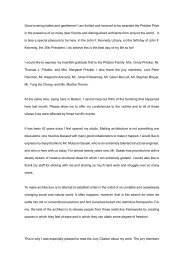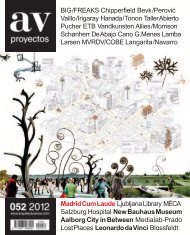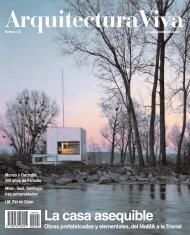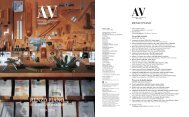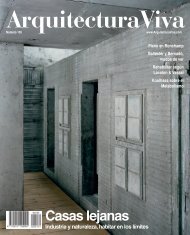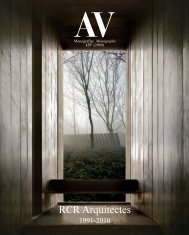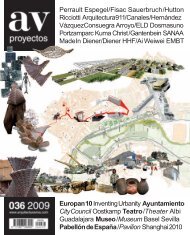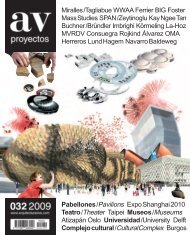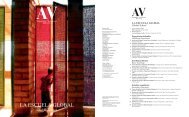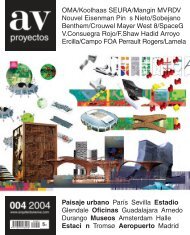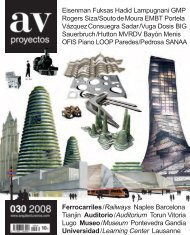La biblioteca digital - Arquitectura Viva
La biblioteca digital - Arquitectura Viva
La biblioteca digital - Arquitectura Viva
- No tags were found...
You also want an ePaper? Increase the reach of your titles
YUMPU automatically turns print PDFs into web optimized ePapers that Google loves.
<strong>Arquitectura</strong><strong>Viva</strong>Número 135www.<strong>Arquitectura</strong><strong>Viva</strong>.comDel Atlas de Warburg alos Pasajes de Benjamin<strong>La</strong>utner y Quaroni,centenarios extremosAntonio Miró, 1931-2011Canadá, Mega y MicroJapón y el mundo árabe,sismos culturales<strong>La</strong> <strong>biblioteca</strong> <strong>digital</strong>Eisenman, Ferrater, Dudler, BFM, Ito, Fujimoto
<strong>Arquitectura</strong><strong>Viva</strong>Número 135ContenidoSumarioDirectorLuis Fernández-GalianoDirector de arteJosé Jaime S. YusteDiagramación y redacciónCuca FloresLuis JátivaBeatriz G. <strong>La</strong>zoLeticia OlalquiagaRaquel Congosto<strong>La</strong>ura FernándezEduardo PrietoLys VillalbaCoordinación editorial<strong>La</strong>ura MulasProducción<strong>La</strong>ura GonzálezJesús PascualAdministraciónFrancisco SolerSuscripcionesLola GonzálezDistribuciónMar RodríguezPublicidadCecilia RodríguezRaquel VázquezRedacción y administración<strong>Arquitectura</strong> <strong>Viva</strong> SLAniceto Marinas, 32E-28008 MadridTel: (+34) 915 487 317Fax: (+34) 915 488 191AV@<strong>Arquitectura</strong><strong>Viva</strong>.comwww.<strong>Arquitectura</strong><strong>Viva</strong>.comPrecio: 18 euros© <strong>Arquitectura</strong> <strong>Viva</strong>Esta revista ha recibido una ayuda de la DirecciónGeneral del Libro, Archivos y Bibliotecas delMinisterio de Cultura para su difusión en <strong>biblioteca</strong>s,centros culturales y universidades de España para latotalidad de los números del año.Depósito legal: M. 17.043/1988ISSN: 0214-1256Distribución en quioscos: CoedisImpresión: Artes Gráficas Palermo, S.L.Cubierta: Biblioteca de Galicia en Santiago deCompostela, de Peter Eisenman.Foto: Duccio MalagambaTraducciones: E. Prieto (Oechslin, Darnton, Ingersoll,Escher, Aureli); C. Lorenzo (Boddy); L. Mulas (inglés)<strong>La</strong> <strong>biblioteca</strong> <strong>digital</strong>. <strong>La</strong> <strong>biblioteca</strong> ha sido a los libros lo que la escriturafue a la memoria: la garante y custodia del saber. Hoy, sin embargo, el libro hamutado y ya no aspira a reposar en las <strong>biblioteca</strong>s sino a desmadejar sus contenidosen la Red. <strong>La</strong> <strong>digital</strong>ización del mundo parece ser, por fin, una realidad.El conocimiento pierde cuerpo, deja de ser material y toda la tradición culturalmoderna, construida a partir de la manipulación de los medios impresos, setransforma. En este contexto surge una nueva fenomenología de la lectura a laque le compete repensar el espacio tradicional de las <strong>biblioteca</strong>s.Tema de portadaEspacios sin papel. Si la edición electrónica y la creciente difusión delsaber por los medios <strong>digital</strong>es amenazan con abocar al libro impreso a ser unasimple rareza para los coleccionistas, cabría pensar que el espacio convencionalde las <strong>biblioteca</strong>s —organizado desde y para los libros— también corre elriesgo de extinguirse. Sin embargo, pese a que sus funciones tradicionales dealmacenamiento tienden a desaparecer, otras dimensiones de su uso —socialesy representativas— siguen gozando de buena salud. Los cambios, por otrolado, no han sido aún tan intensos como para alterar la concepción tipológica yestética de las <strong>biblioteca</strong>s. Seis ejemplos —dos muy diferentes en España, unacompacta pareja berlinesa y un dúo minimalista japonés— dan cuenta de este inacabadoproceso de transformación que sufren las <strong>biblioteca</strong>s contemporáneas.Argumentos y reseñasCentenarios extremos. Se cumplen cien años del nacimiento de dosfiguras dispares de la arquitectura del siglo XX: John <strong>La</strong>utner, maestro de laplástica estructural, y Ludovico Quaroni, teórico de las utopías urbanas.Pasajes y colecciones. <strong>La</strong> coincidencia de dos muestras en Madrid—unaen el Círculo de Bellas Artes dedicada a Walter Benjamin; otra en el MNCARSinspirada en Aby Warburg— permite comparar y actualizar la obra de ambos.Posmodernidad revisada. Dos libros actualizan el movimiento posmoderno;Francisco Javier San Martín reseña El sistema del arte en España, elúltimo libro de Juan Antonio Ramírez; además, paisajismo y libros recibidos.Últimos proyectosEscala en Canadá. <strong>La</strong> arquitectura canadiense contemporánea prefiererehuir los términos medios para trabajar en los extremos, bien en la gran escalade los edificios híbridos multifuncionales, bien en la pequeña de los humildespabellones que dialogan con una naturaleza casi virgen. Un texto crítico introductorioanaliza este particular contexto; tres obras significativas lo ilustran.Para terminar, con ocasión de los recientes acontecimientos acaecidos enJapón —un terremoto geológico— y en los países árabes —un terremoto político—,Luis Fernández-Galiano desvela la fragilidad de nuestras arquitecturasmateriales y sociales, poniendo de manifiesto cómo ambas crisis, sin embargo,pueden apuntar creativamente a otros modelos de crecimiento más sostenibles.19 Werner OechslinBibliotecas y principios20 María Luisa López-Vidriero<strong>La</strong> soledad de la lectura22 Robert DarntonDigitalizar es democratizar26 Richard IngersollLos espacios de BabelBibliotecas, 2000-2010<strong>Arquitectura</strong>32 Peter EisenmanBiblioteca y archivo de Galicia40 Carlos FerraterBiblioteca en Villarreal44 Max DudlerBiblioteca Humboldt, Berlín50 Bruno Fioretti MárquezBiblioteca en Köpenick, Berlín54 Toyo ItoBiblioteca de Tama, Tokio58 Sou FujimotoBibioteca en Kodaira, TokioArte / Cultura65 Frank EscherJuegos estructurales68 Pier Vittorio AureliIdeales frustrados70 Eduardo PrietoConstelaciones modernas72 Simón MarchánAtlas contemporáneos74 Historietas de FochoThe Magic Mountain75 Autores variosLibrosTécnica / Diseño84 Boddy, Lo Mega y lo Micro92 Patkau, Centro Beaty96 MacKay-Lyons & SweetappleEscuela taller100 Shim-SutcliffeEdificio comedor107 ProductosPavimentos110 Resumen en inglésThe Digital Library112 Luis Fernández-GalianoBailando con cadenas
ContentsSynopses19 Werner OechslinLibraries and Beginnings20 María Luisa López-VidrieroThe Solitude of Reading22 Robert DarntonDigitalizing is Democratizing26 Richard IngersollThe Spaces of BabelLibraries, 2000-2010Architecture32 Peter EisenmanLibrary and Archive of Galicia40 Carlos FerraterLibrary in Villarreal44 Max DudlerHumboldt Library, Berlin50 Bruno Fioretti MárquezLibrary in Köpenick, Berlin54 Toyo ItoLibrary in Tama, Tokyo58 Sou FujimotoLibrary in Kodaira, TokyoArt / Culture65 Frank EscherStructural Games68 Pier Vittorio AureliFrustrated Ideals70 Eduardo PrietoModern Constellations72 Simón MarchánContemporary Atlas74 pp Focho’s CartoonA The famous Magic architect Mountain75 pp Various AuthorsBooksTechnique / Style84 Boddy, Mega and Micro92 Patkau, Beaty Center96 MacKay-Lyons & SweetappleSchool-Workshop100 Shim-SutcliffeDining Hall Building107 ProductsPavements110 English SummaryThe Digital Library112 Luis Fernández-GalianoDancing in ChainsThe Digital Library. The library has been to books what writing wasto memory: the guarantor and custodian of knowledge. Today, however, thebook has changed and no longer hopes to remain in libraries, but to unravelits contents in the web. The <strong>digital</strong>ization of the world seems to be, finally, areality. Knowledge loses body, ceases to be material and all the modern culturaltradition, which has developed from the manipulation of printed matter, istransformed. This context gives rise to a new phenomenology of reading, whichis awarded the task of rethinking the traditional space of libraries.Cover StorySpaces without Content. If electronic editions and the growing disseminationof knowledge through <strong>digital</strong> media threaten to turn printed booksinto collectors’ items, one would think that the conventional space of libraries– organized from and for books – also runs the risk of become extinct. Nevertheless,although the traditional functions of storage tend to disappear, otherdimensions of their use – social and representative – continue to enjoy goodhealth. Changes, on the other hand, have not been intense enough so as toalter the typological and aesthetic conception of libraries. Six examples – twovery different ones in Spain, a compact Berlinese couple and a minimalistJapanese duo – take stock of this still unconcluded transformation process thatcontemporary libraries are currently undergoing.Views and ReviewsExtreme Centennials. A hundred years have passed since the birth oftwo very different figures of 20th century architecture: John <strong>La</strong>utner, masterof structural aesthetics, and Ludovico Quaroni, theoritician of urban utopias.Passages and Collections. Two simultaneous Madrid exhibitions – oneat the Círculo de Bellas Artes on Walter Benjamin and another at the MNCARSinspired in Aby Warburg – permit comparing and updating both oeuvres.Postmodernity Revised. Two books update the postmodern movement;Francisco Javier San Martín reviews El sistema del arte en España, the last bookby Juan Antonio Ramírez; besides, texts on landscaping and books received.Interiors, Design, ConstructionStopover in Canada. Contemporary Canadian architecture rathers departingfrom the happy medium and approaches the extremes, be it in the large scaleof hybrid multifunctional buildings, or in the small scale of humble pavilionsthat dialogue with an almost virgin natural environment. A critical introductorytext analyzes this specific context; three significant works illustrate it.To close, the recent dramatic events in Japan – a geological earthquake –and in the Arab countries – a political earthquake – are the guiding thread ofan article in which Luis Fernández-Galiano speaks about the fragility of ourmaterial To close, and Comment social architectures, in 4 blocks of evidencing, 2 lines. however, how both crises cancreatively 2 suggest other more sustainable models of growth.
<strong>La</strong> <strong>biblioteca</strong> <strong>digital</strong>Si el libro es una máquina para pensar, entonces las <strong>biblioteca</strong>s son fábricasde pensamiento. Esas industrias intelectuales, sin embargo, se enfrentan ennuestros días a la mutación de sus herramientas, y el libro <strong>digital</strong> impulsa eltránsito contemporáneo de las <strong>biblioteca</strong>s desde el espacio arquitectónicohacia el nodo informático. <strong>La</strong> primera revolución de la escritura, hace casidos milenios, sustituyó el rollo por el códice, y esa innovación extraordinariade las páginas encuadernadas hizo posible el acceso cómodo y rápido a lainformación depositada entre sus cubiertas; la segunda revolución, hace algomás de medio milenio, reemplazó el manuscrito por la imprenta, y lareproduccion mecánica facilitó una multiplicación espectacular de los textos;la tercera, de la que nos ha tocado ser testigos, ha efectuado el tránsito delimpreso físico a la información <strong>digital</strong>, y con ella una formidable explosiónde la disponibilidad y del acceso.Del papiro al pergamino, del pergamino al papel y del papel al bit.Recorriendo esta ruta, enseguida se advierte que la última metamorfosis tieneuna naturaleza distinta a las anteriores, porque al pasar del universo materialde los rollos, los códices o los libros al mundo virtual de las redes lasnecesidades espaciales de las <strong>biblioteca</strong>s convencionales se desvanecen.Desde el mundo clásico hasta el siglo XX, las <strong>biblioteca</strong>s han sido a la vezdepósitos de manuscritos o impresos y lugares para su consulta, pero ni losunos ni los otros parecen ya imprescindibles: tanto los almacenes como lassalas de lectura serán —nos dicen— progresivamente reemplazados por losarchivos informáticos y las pantallas individuales, haciendo innecesarios losedificios específicos y convirtiendo las actuales <strong>biblioteca</strong>s en arquitecturasprescindibles, fósiles construidos de una era de la información periclitada deforma definitiva. ¿Es ese su destino?Por más que las tribulaciones de editores o libreros dibujen los perfiles deun paisaje de crisis, las <strong>biblioteca</strong>s tienen todavía esperanzas fundadas desupervivencia, como atestigua la adaptación de las grandes instituciones a lasdemandas de la red —que han sabido hacer compatibles con sus funcionestradicionales—, así como la profusión y popularidad de las de menor escala,convertidas en centros sociales que ofrecen a jóvenes y ancianos comodidady silencio, además de libros, revistas o conexiones de internet. Al cabo, losseres humanos gustamos del encuentro, y ni el teletrabajo puede sustituir lavitalidad interactiva de la oficina, ni la lectura en pantallas dispersas puedereemplazar el contacto informal en los centros de investigación, los lugaresde enseñanza o las <strong>biblioteca</strong>s. Al igual que la educación a distancia no hizodesaparecer la llamada ‘presencial’, la <strong>biblioteca</strong> a distancia tampoco haráobsoleta nuestra <strong>biblioteca</strong> material.Luis Fernández-GalianoIf a book is a machine for thinking, then librariesare thought factories. The tools of these intellectualindustries, however, are undergoing a completetransformation in these days, and the <strong>digital</strong> booktriggers the contemporary transition of librariesfrom architectural space to the computer node.The first revolution of writing, almost two thousandyears ago, replaced the roll by the codex, and theextraordinary innovation of bound pages enableda comfortable and fast access to the informationenclosed between its covers; the second revolution,more than five hundred years ago, replaced themanuscript with printing, and mechanicalreproduction led to a spectacular multiplicationof texts; the third, which we are now witnessing,has spurred a transition from printed matter to<strong>digital</strong> information, and with it a huge explosionof availability and access.From papyrus to parchment, from parchment topaper and from paper to bytes. Covering this routeone soon sees that the last metamorphosis is ratherdifferent than the previous one, because whenpassing from the material universe of rolls, codicesor books to the virtual world of networks the spatialneeds of conventional libraries fade away. From theclassical world to the 20th century, libraries havebeen at once deposits for manuscripts or printedmatter and places in which to study them, but neitherone nor the other seem essential nowadays: bothstorage areas and reading halls will be – most seemto think – progessively replaced by computer filesand individual screens, thereby making specificbuildings unncessary and rendering our belovedlibraries superfluous architectures, built fossiles ofan information age that is reaching its demise.Is that indeed their fate?Even though the present troubles of booksellersand editors may describe a landscape of crisis,libraries still have justified hopes for survival, asevidenced by the adaptation of large institutions tothe web’s demands – which they have managed tomake compatible with their traditional functions –,as well as by the profusion and popularity of thesmaller ones, transformed into social centers that,besides offering books, magazines or internetconnection, provide comfortable and quiet premisesfor the young and the elderly. After all, humanbeings like getting together, and working from homecannot replace the interactive vitality of an office,nor can reading on lonely screens replace the casualcontact in research centers, universities or libraries.Just like distance learning did not make classroomsdisappear, the virtual library will not entail the finalextinction of our resilient material library.<strong>Arquitectura</strong><strong>Viva</strong> 135 2010 3



